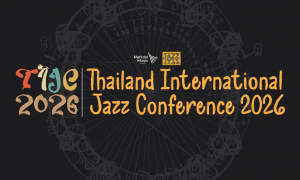May 25, 2010
On Saxophonist's Own Hate Laugh Music
Release Shows Scheduled For
May 28 at Tea Lounge in Park Slope, Brooklyn
May 29 at Cornelia Street Cafe in East Village
Live recordings may be a cliche in rock music, but in jazz--as bandleader Pete Robbins notes--they are the very measure of the music. They reveal exactly what a group is made of, fully embracing the “first thought, best thought" Zen of improvisation and human chemistry that inspires electrifying moments on the bandstand.
“The concert is such a big part of the experience," Robbins says. “You have great musicians who play the same songs totally different every time." As the alto saxophonist discovered making his first live --featuring his stellar working ensemble siLENT Z, the experience opens up dimensions of sound and spontaneity that rarely exist in the studio. “My last record [Do the Hate Laugh Shimmy (Fresh Sound New Talent)] was very scripted. We spent a whole day in the studio, very tightly scheduled and the arrangements were predetermined I felt like I could keep tweaking it until I got what I wanted. But with the live record I can't do anything. Shimmy came out great but it lacked the intensity of our live shows. I thought the next logical thing was to record this band live.
And what a band it is. As New York audiences who have seen Robbins and his cohorts perform at venues such as The Cornelia Street Cafe and the Tea Lounge in Brooklyn's Park Slope neighborhood know, the electro-acoustic quintet is one of the city's best working outfits. “Pete has a surprising amount and type of creativity," says Joe Morris, one of Robbins' teachers during his formative college years and himself a brilliant, dogged composer and improviser on guitar, bass and banjo. “He's a great and unique writer and alto player. He's brave and his music is fun but also artistic."
Critics also have been impressed. “Robbins composes like a jazz musician but envisions a broader jumble informed by various indie genres," wrote critic David Adler in Time Out New York. “Highly developed harmony, complex meter and searing improv merge with a world of experimental loops, ambient soundscapes, hard beats and general abandon. The '70s term jazz-rock doesn't cut it, so the best description of a project like siLENT Z is probably the artist's own: Brooklyn prog-modern (post)jazz'."
 siLENT Z features Robbins on alto, Jesse Neuman on cornet and effects, Mike Gamble on guitar and effects, Thomas Morgan on bass, Tyshawn Sorey on drums, and special guest pianist Cory Smythe. It's a cross-section of young talents with remarkable verve, ideally suited to Robbins' purposes as a composer. “Even without the effects, Jesse is an incredible musician," Robbins says. “His sense of melody is so strong he can play anything and make it sound beautiful. And he has such a great sense of what effects to use, when and how, that he never ceases to amaze me. I went to the New England Conservatory with Mike in the late '90s. He's great with all the delays and effects. He lends that rock feel my tunes cry out for sometimes, but he can also play quote-unquote jazz guitar."
siLENT Z features Robbins on alto, Jesse Neuman on cornet and effects, Mike Gamble on guitar and effects, Thomas Morgan on bass, Tyshawn Sorey on drums, and special guest pianist Cory Smythe. It's a cross-section of young talents with remarkable verve, ideally suited to Robbins' purposes as a composer. “Even without the effects, Jesse is an incredible musician," Robbins says. “His sense of melody is so strong he can play anything and make it sound beautiful. And he has such a great sense of what effects to use, when and how, that he never ceases to amaze me. I went to the New England Conservatory with Mike in the late '90s. He's great with all the delays and effects. He lends that rock feel my tunes cry out for sometimes, but he can also play quote-unquote jazz guitar."
Bassist Thomas Morgan is, simply, “one of the best musicians I know," Robbins says. “He can sight-read anything and makes everyone around him better." And Sorey, a drummer and composer who leads or participates in several celebrated ensembles, including a trio with Robbins and bassist Mario Pavone, is “a complete savant."
Robbins offers an example: “Tyshawn can sit at the piano, and I'll say, 'Play the B section from the second track of my second record and he'll just play it. He's a genius that way. Like Mike, he can take any style and make it authentic." Sorey's impending “sabbatical" from regular live performance as he pursues an advanced degree in composition also was a motivation for Robbins' to capture siLENT Z's playfully complex mojo in a club setting. Robbins approachs each of the album's tracks as a particular challenge. The opening number, “edit/revise," started out simply enough. “I really wanted to write something in 4/4. I haven't done that in a long time," he explains. “I guess I halfway succeeded." But the piece shifts into a more complex second part that translates the influence of UK electronic pioneers Autechre, via Sorey's astonishingly nimble percussion.
The touching “his life, for all its waywardness" is a prime slice of siLENT Z and its wide-open best. The piece opens with the bittersweet atmospherics of Gamble's guitar and effects, seemingly drifting in a sublime manner before the mood shifts, crackling with a fiery dialogue between Robbins' horn and Sorey's fast-rattling stick-work. “Jazz these days can get so bogged down in harmony and the subtleties of chord progressions and to me, if I really want to analyze a song, then I can appreciate those things, but I feel like in my head that idea is very much tied up with the ivory tower of jazz consumption: musicians making music for other nusicians," Robbins says. “So the idea was to make this really simple harmonically, just totally in the key of C. And all white keys pretty much. Keep it kind of droney and moody, but also substantial underneath with this guitar lick in 15/8 and also a 4/4 bass line. I can't keep it too simple. My brain won't let me do it. But I wanted to make it accessible and also interesting."
As a young musician in 7th grade, Robbins tried his hand at other instruments, like the clarinet, but found his destiny one day when his father, a jazz and classical enthusiast, sat him down and played him three records. “Miles, Bird and Dexter Gordon," he says. “Dad told me, Trumpet, alto or tenor. Those are your options.' Charlie Parker stuck out for me because he played so fast." Later revelations came when, as a high school student, Robbins heard the late saxophonist Thomas Chapin at one of his final gigs. “It was a whole other way to play jazz, and it really turned me on." Likewise, the discovery of the prolific altoist Tim Berne's quartet Bloodcount proved a real turning point.
“I didn't know what was going on the first time I heard it," Robbins says, referencing the triple-live CD Unwound. “I knew something incredible was happening but had no idea what it was." What it was, he now relates, was “Jim Black's drumming and the way that he and [bassist Michael] Formanek played together. Their time together was like this giant monster brainy groove. The thing I'd been looking for forever. That and way they would go in and out of more abstract, semi-structured improv and very rock-heavy odd-meter grooves that are not really tonal. It was exactly what was appealing to me."
Though the music Robbins invents with siLENT Z almost insists on evading easy definition, the bandleader gives it another shot. “Even now, that's what I'm trying to accomplish, covering free stuff and odd meter like prog-rock influence jazz nerdy grooves... or something."























